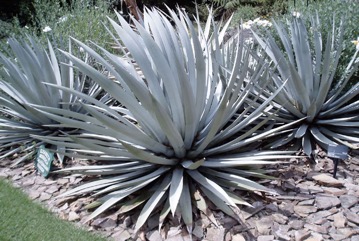Century plant, Parry's Agave

It occurs naturally in South-western North America from Arizona to New Mexico in semiarid land between 1300-2400 metres, often experiencing snow in winter with temperatures as low as -18°C for short periods. It suits hardiness zones 7-11. It suits gritty, well drained soils.
Also known as:
Parry's Century-plant
Synonyms
- Agave americana var. latifolia Torr.
- Agave chihuahuana Trel.
- Agave parryi subsp. parryi
- Agave parryi var. parryi
- Agave patonii Trel.
Edible Portion
- Young shoot, Seeds, Flower stalks, Leaves, Sap
Where does Century plant grow?
Found in: Australia, Central America, Mexico, North America, United States
Notes: There are about 250 Agave species. The Agavaceae are mostly in the tropics and subtropics.
Status: It has been an important food of some groups of people.
Growing Century plant, Parry's Agave
Cultivation: Plants can be grown from seed. Seed should be sown on the surface and germinate in 1-3 months at 20°C. The seedlings should be grown in a sunny position until 20 cm tall. Plants can also be grown from offshoots.
Edible Uses: The heart of the plant can be eaten after baking. It is sweet but fibrous. The seed is ground into flour and used to thicken soups. The flower stalk can be roasted and used like asparagus. The young leaves are eaten roasted. Sap from the cut flowering stems can be used as a syrup.
Production: The flower lives for a number of years without flowering but dies once it does flower. Suckers however continue to grow. Suckers flower after 15 years in warm climates. Plants are very slow growing.
Nutrition Info
per 100g edible portion| Edible Part | Energy (kcal) | Protein (g) | Iron (mg) | Vitamin A (ug) | Vitamin c (mg) | Zinc (mg) | % Water |
|---|---|---|---|---|---|---|---|
| Heart of plant | - | - | - | - | - | - | |
| Seeds | - | - | - | - | - | - | |
| Flower stalk | - | - | - | - | - | - | |
| Sap | - | - | - | - | - | - |
Century plant, Parry's Agave Photos

References
Anderson, M., 2002, The World Encyclopedia of Cacti and Succulents. Hermes House, New York. p 126
Beckstrom-Sternberg, Stephen M., and James A. Duke. "The Foodplant Database." http://probe.nalusda.gov:8300/cgi-bin/browse/foodplantdb.(ACEDB version 4.0 - data version July 1994)
Brickell, C. (Ed.), 1999, The Royal Horticultural Society A-Z Encyclopedia of Garden Plants. Convent Garden Books. p 89
CASTETTER,
Cundall, P., (ed.), 2004, Gardening Australia: flora: the gardener's bible. ABC Books. p 115
Etkin, N.L. (Ed.), 1994, Eating on the Wild Side, Univ. of Arizona. p 70
Facciola, S., 1998, Cornucopia 2: a Source Book of Edible Plants. Kampong Publications. p 3
Hedrick, U.P., 1919, (Ed.), Sturtevant's edible plants of the world. p 29
MINNIS
Nugent, J., 1999, Agaves and cacti., Permaculture plants. Sustainable Agriculture Research Institute. PO Box 10, Nanup, WA, 6275 (As Agave patonii)
Plants for a Future database, The Field, Penpol, Lostwithiel, Cornwall, PL22 0NG, UK. http://www.scs.leeds.ac.uk/pfaf/
Trans. Acad. Sci. St. Louis 3:310. 1875
World Checklist of Useful Plant Species 2020. Royal Botanic Gardens, Kew